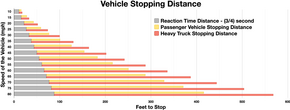This article needs additional citations for verification. (January 2007) |

Braking distance refers to the distance a vehicle will travel from the point when its brakes are fully applied to when it comes to a complete stop. It is primarily affected by the original speed of the vehicle and the coefficient of friction between the tires and the road surface,[Note 1] and negligibly by the tires' rolling resistance and vehicle's air drag. The type of brake system in use only affects trucks and large mass vehicles, which cannot supply enough force to match the static frictional force.[1][Note 2]
The braking distance is one of two principal components of the total stopping distance. The other component is the reaction distance, which is the product of the speed and the perception-reaction time of the driver/rider. A perception-reaction time of 1.5 seconds,[2][3][4] and a coefficient of kinetic friction of 0.7 are standard for the purpose of determining a bare baseline for accident reconstruction and judicial notice;[5] most people can stop slightly sooner under ideal conditions.
Braking distance is not to be confused with stopping sight distance. The latter is a road alignment visibility standard that provides motorists driving at or below the design speed an assured clear distance ahead (ACDA)[6] which exceeds a safety factor distance that would be required by a slightly or nearly negligent driver to stop under a worst likely case scenario: typically slippery conditions (deceleration 0.35g[7][Note 3]) and a slow responding driver (2.5 seconds).[8][9] Because the stopping sight distance far exceeds the actual stopping distance under most conditions, an otherwise capable driver who uses the full stopping sight distance, which results in injury, may be negligent for not stopping sooner.
Cite error: There are <ref group=Note> tags on this page, but the references will not show without a {{reflist|group=Note}} template (see the help page).
- ^ Fricke, L. (1990). "Traffic Accident Reconstruction: Volume 2 of the Traffic Accident Investigation Manual". The Traffic Institute, Northwestern University.
{{cite journal}}: Cite journal requires|journal=(help) - ^ Taoka, George T. (March 1989). "Brake Reaction Times of Unalerted Drivers". ITE Journal. 59 (3): 19–21. ISSN 0162-8178.
- ^ The National Highway Traffic Safety Administration (NHTSA) uses 1.5 seconds for the average reaction time.
- ^ The Virginia Commonwealth University’s Crash Investigation Team typically uses 1.5 seconds to calculate perception-reaction time
- ^ "Tables of speed and stopping distances". The State of Virginia.
- ^ ACDA or "assured clear distance ahead" rule requires a driver to keep his vehicle under control so that he can stop in the distance in which he can see clearly
- ^ National Cooperative Highway Research Program (1997). NCHRP Report 400: Determination of Stopping Sight Distances (PDF). Transportation Research Board (National Academy Press). p. I-13. ISBN 0-309-06073-7.
- ^ American Association of State Highway and Transportation Officials (1994) A Policy on Geometric Design of Highways and Streets (Chapter 3)
- ^ Highway Design Manual. Vol. 6th Ed. California Department of Transportation. 2012. p. 200. See Chapter 200 on Stopping Sight Distance and Chapter 405.1 on Sight Distance